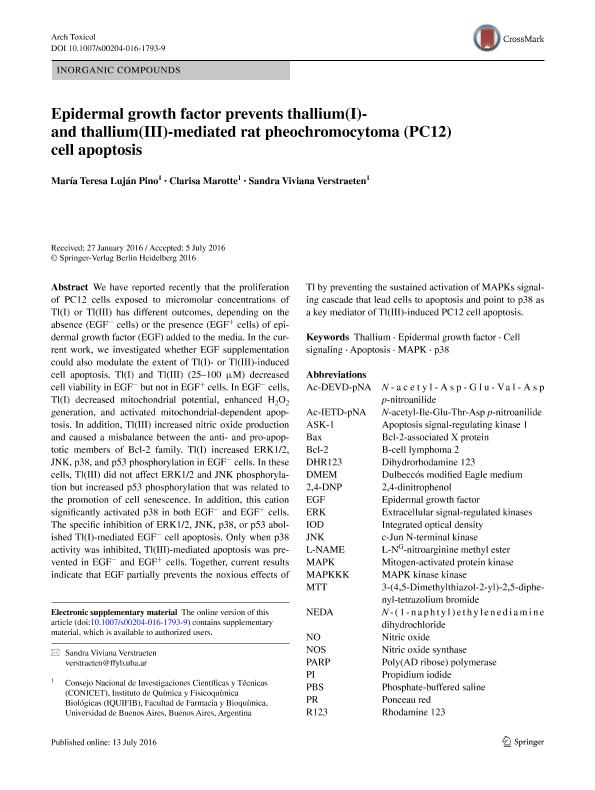Artículo
Epidermal growth factor prevents thallium(I)- and thallium(III)-mediated rat pheochromocytoma (PC12) cell apoptosis
Fecha de publicación:
03/2017
Editorial:
Springer
Revista:
Archives of Toxicology
ISSN:
0340-5761
Idioma:
Inglés
Tipo de recurso:
Artículo publicado
Clasificación temática:
Resumen
We have reported recently that the proliferation of PC12 cells exposed to micromolar concentrations of Tl(I) or Tl(III) has different outcomes, depending on the absence (EGF− cells) or the presence (EGF+ cells) of epidermal growth factor (EGF) added to the media. In the current work, we investigated whether EGF supplementation could also modulate the extent of Tl(I)- or Tl(III)-induced cell apoptosis. Tl(I) and Tl(III) (25–100 μM) decreased cell viability in EGF− but not in EGF+ cells. In EGF− cells, Tl(I) decreased mitochondrial potential, enhanced H2O2 generation, and activated mitochondrial-dependent apoptosis. In addition, Tl(III) increased nitric oxide production and caused a misbalance between the anti- and pro-apoptotic members of Bcl-2 family. Tl(I) increased ERK1/2, JNK, p38, and p53 phosphorylation in EGF− cells. In these cells, Tl(III) did not affect ERK1/2 and JNK phosphorylation but increased p53 phosphorylation that was related to the promotion of cell senescence. In addition, this cation significantly activated p38 in both EGF− and EGF+ cells. The specific inhibition of ERK1/2, JNK, p38, or p53 abolished Tl(I)-mediated EGF− cell apoptosis. Only when p38 activity was inhibited, Tl(III)-mediated apoptosis was prevented in EGF− and EGF+ cells. Together, current results indicate that EGF partially prevents the noxious effects of Tl by preventing the sustained activation of MAPKs signaling cascade that lead cells to apoptosis and point to p38 as a key mediator of Tl(III)-induced PC12 cell apoptosis.
Palabras clave:
Apoptosis
,
Cell Signaling
,
Epidermal Growth Factor
,
Thallium
,
Mapk
,
P38
Archivos asociados
Licencia
Identificadores
Colecciones
Articulos(IQUIFIB)
Articulos de INST.DE QUIMICA Y FISICO-QUIMICA BIOLOGICAS "PROF. ALEJANDRO C. PALADINI"
Articulos de INST.DE QUIMICA Y FISICO-QUIMICA BIOLOGICAS "PROF. ALEJANDRO C. PALADINI"
Citación
Pino, María Teresa Luján; Marotte, Clarisa; Verstraeten, Sandra Viviana; Epidermal growth factor prevents thallium(I)- and thallium(III)-mediated rat pheochromocytoma (PC12) cell apoptosis; Springer; Archives of Toxicology; 91; 3; 3-2017; 1157-1174
Compartir
Altmétricas




